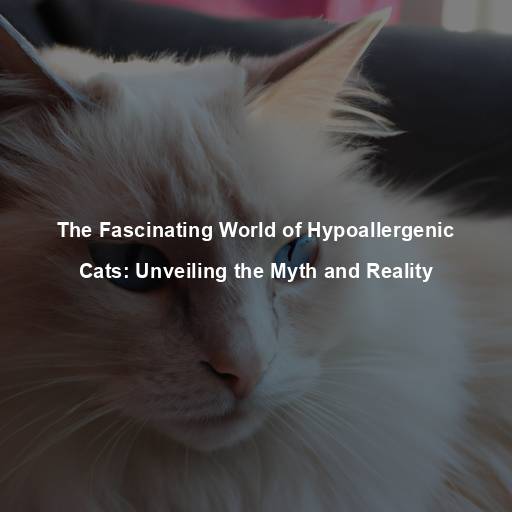Do Cats See in the Dark?
Last Updated on July 21, 2023 by Evan
Contents [hide]
Understanding a Cat’s Night Vision
Cats have always been mysterious creatures, captivating us with their enigmatic behaviors and unique abilities. One of the most intriguing aspects of a cat’s nature is their ability to navigate and hunt in low-light conditions. We often hear the saying that cats can see in the dark, but what is the truth behind this statement? Let’s delve into the fascinating world of feline night vision and uncover the secrets that lie within their mesmerizing eyes.
The Nighttime Predators
Cats, both big and small, are natural-born predators. Their ancestors were solitary hunters who roamed the night, using their exceptional night vision to stalk and capture prey. This nocturnal instinct has been passed down through the generations, allowing our domesticated cats to retain their exceptional visual abilities in low-light conditions.
The Structure of a Cat’s Eye
To understand how cats see in the dark, we must first examine the structure of their eyes. Like humans, cats have two types of cells in their retinas: rods and cones. While cones are responsible for color vision and detail, it is the abundance of rod cells in a cat’s eyes that sets them apart. Rod cells are highly sensitive to light and are essential for vision in dimly lit environments.
The Magic Behind Cat Eyes
Cats have a remarkable adaptation in their eyes called the tapetum lucidum. This structure, located behind the retina, acts as a mirror and reflects light back through the rod cells, maximizing their sensitivity. This reflective layer gives cat eyes their characteristic glow and enhances their night vision capabilities.
The Advantage of Night Vision
So, how well can cats actually see in the dark? While cats cannot see in complete darkness, their night vision far surpasses that of humans. They possess the ability to perceive objects in extremely low-light conditions, thanks to their highly sensitive rod cells and the reflective tapetum lucidum. This advantage allows them to navigate their surroundings, hunt for prey, and avoid obstacles even in dimly lit environments.
The Spectrum of Cat Vision
When it comes to cats and their nocturnal prowess, their visual prowess veers far off the beaten path of our own. Sure, they may excel in dimly-lit environments, but their optic outlook isn’t quite the same as ours. You see, these furry felines have a rather intriguing twist on color perception – their cones, those handy little cells responsible for detecting colors, are in shorter supply compared to us mere humans. This means that our vibrant world gets a bit muted in their eyes, with an added emphasis on the cool hues of blue and green.
Adaptations for Survival
Cats, those mysterious creatures we can never fully comprehend, possess an intriguing array of survival tools bestowed upon them by the ever-evolving forces of nature. Take their enigmatic slit-shaped pupils, for instance. These fascinating ocular features possess the uncanny ability to expand and contract in an instant, enabling our feline friends to skillfully regulate the influx of light penetrating their mesmerizing eyes. It is this peculiar adaptation, coupled with their awe-inspiring night vision capabilities, that catapults them into the realm of unparalleled predators, covertly stalking their unsuspecting prey with unwavering accuracy and deep-rooted precision.
Enhancing Night Vision
Cats are known for their exceptional night vision, but did you know that there are various factors that can, on top of that, further enhance their ability to see in the dark? Age, breed, and individual differences can all play a role in a cat’s eyesight. To ensure their visual health, it’s important to provide them with a well-rounded diet full of essential nutrients, like Vitamin A. Furthermore, keeping their surroundings well-lit during the nighttime can help them navigate and avoid any mishaps. Who knew the feline eye had so much complexity?
Unveiling the Mysteries of Cat Eyes
The mesmerizing way cats navigate the darkness has always captivated our curious minds, fueling our fascination with these enigmatic beings. Their ability to see in low-light conditions, although not complete darkness, is truly remarkable. It is their extraordinary adaptations, such as their highly sensitive rod cells, the reflective tapetum lucidum, and their superior visual acuity that make them the ultimate nocturnal hunters. Cats, with their mysterious behaviors and unparalleled night vision, continue to bewitch and perplex us.
As we continue to explore the depths of feline night vision, we gain a deeper appreciation for the wonders of nature and the unique abilities of the animal kingdom. So, the next time you catch your feline companion gazing into the night with their luminous eyes, remember the secrets they hold and the ancient instincts that guide them through the darkness. ## The Evolution of Night Vision in Cats
A Journey Through Time
To truly grasp the extent of a cat’s night vision capabilities, we must delve into their evolutionary history. Cats, as we know them today, belong to the Felidae family, which includes both big cats like lions and tigers, as well as domesticated cats. These feline species share a common ancestor that lived millions of years ago and possessed adaptations for hunting in low-light environments.
Ancient Ancestors: The Origins of Night Vision
The earliest feline ancestors were small, nocturnal mammals that roamed the Earth during the Eocene epoch, approximately 50 million years ago. These ancient cats had eyes specifically adapted for hunting at night, with larger pupils and a higher concentration of rod cells in their retinas. These adaptations allowed them to take advantage of the abundant prey available during the cover of darkness.
Survival of the Fittest
Throughout the course of history, feline species embarked on a mesmerizing journey of transformations, navigating the never-ending maze of evolution. The artistry of natural selection favored those fortunate enough to possess extraordinary night vision, a veritable treasure in the relentless pursuit of prey. As the sun set on each passing generation, these feline visionaries triumphed in the eternal dance of survival, bequeathing their mystical talents to their descendants, forever etching their names in the annals of evolution.
The Domestication Factor
As humans began to domesticate cats, these night vision adaptations remained preserved. Despite the comfortable life that many domestic cats now lead, their eyes still retain the remarkable night vision capabilities of their wild ancestors. This is one of the reasons why our feline companions can navigate our homes effortlessly, even in poorly lit areas.
Understanding the Science Behind Night Vision
The Role of Rod Cells
When the sun goes down and darkness takes over, our feline friends step into the spotlight with their mesmerizing night vision skills. At the heart of their nocturnal superpower lies the enigmatic rod cells, playing an intriguing role in their visual prowess. These remarkable cells possess a unique sensitivity to light, allowing cats to effortlessly seize every sneaky motion and decipher faint shapes even in the most shadowy corners. While we humans boast a dazzling array of cone cells for vibrant hues, our furry companions excel with their abundant army of rod cells, unraveling the mysterious secrets concealed in the darkness.
The Tapetum Lucidum: A Reflective Advantage
One of the most intriguing aspects of a cat’s night vision is the tapetum lucidum, a reflective layer located behind the retina. This structure acts as a mirror, reflecting light back through the rod cells and maximizing their sensitivity. It’s this reflective layer that creates the mesmerizing glow in a cat’s eyes and enhances their ability to see in the dark.
Pupil Dilation: Adjusting to the Darkness
Isn’t it absolutely mind-boggling how cats can effortlessly adjust the size of their pupils? It’s like they have this superpower to instantly adapt to different lighting situations. In the darkness, their eyes widen, as if absorbing every single ray of light available, while in bright sunlight, they narrow down to shield their delicate retinas from an overwhelming glare. The way they seamlessly toggle between these two extremes is a true testament to the intricate design of nature.
The World Through a Cat’s Eyes
When it comes to feline vision, things get curiouser and curiouser. Unlike us humans, cats see the world through a slightly distorted lens. While their eyes can’t quite decipher the vibrant spectrum of colors that we so readily revel in, they excel in capturing the subtle blues and greens that often evade our notice. But fret not, for cats have a masterful trick up their furry sleeves – their ability to track the tiniest of movements, be it in broad daylight or under the enigmatic cloak of night.
Exploring the Wonders of Cat Vision
The Hunt in the Dark
It’s a captivating play of shadows and secrets that sets cats apart as nature’s stealthiest hunters. From the whimsical domestic feline on the prowl for a dangling toy to the majestic tiger stalking its prey under the moonlit sky, their enigmatic night vision remains a baffling enigma. Through an intricate web of intricate rods and a mysterious reflective tapetum lucidum, these cunning creatures unlock the secrets of the dark, acquiring a mysterious advantage in the hunt. In the realm of low-light conditions, their senses become finely tuned to detect even the subtlest movements, a bewildering mastery that leaves us in awe.
When it comes to prowling through the shadows, cats are true masters of the night. Their keen eyesight not only helps them spot their prey during hunting expeditions but also allows them to effortlessly navigate their surroundings under the cover of darkness. With an extraordinary sense of spatial awareness and the ability to see in the gloomiest of settings, cats effortlessly tiptoe through dimly lit spaces, gracefully leaping onto furniture, and fearlessly exploring their world, even in the absence of sufficient light.
The Beauty of the Night
As twilight descends upon our world, felines emerge from the shadows, enticed by the enigma of the night. Their innate curiosity compels them to embark on nocturnal escapades, traversing the moon-kissed landscape with an elegance that captivates the beholder. With eyes aglow, these mysterious creatures navigate the dark, evoking a profound appreciation for their exceptional ability to perceive the world that lies beyond our human gaze.
Unraveling the Mystery of Cat Eyes
For centuries, cats have left us in awe with their mysterious talent of seeing in the dark. Their mesmerizing eyes and their unparalleled prowess in low-light settings have sparked our curiosity and admiration. The evolution of their rod cells, the presence of the reflective tapetum lucidum, and their remarkable flexibility in adapting to varying lighting conditions all contribute to their mastery of the nocturnal domain. These feline marvels continue to baffle and amaze us with their innate abilities.
So, the next time you find your feline companion gazing out the window at dusk, remember the ancient instincts that lie within them. Their night vision is a testament to their wild heritage and an enchanting reminder of the incredible diversity of life on our planet. ## The Secrets Behind a Cat’s Night Vision
Unveiling the Mysteries
Throughout history, cats have captivated our imaginations with their enigmatic allure, forever shrouded in an air of mystique. Their nocturnal prowess, the ability to see in the darkest of nights, adds another layer of fascination to their already bewitching nature. As we delve into the depths of scientific inquiry, we uncover an ever-growing tapestry of perplexing wonders that surround these majestic creatures. Join us as we embark on a quest to unravel the secrets hidden within the mesmerizing eyes of our feline companions and illuminate the mysteries that lie in wait.
Adaptations for Nocturnal Life
Have you ever wondered how cats are able to effortlessly navigate in the dark? It’s truly fascinating! These mysterious creatures possess a set of physical and physiological adaptations that make them the ultimate nighttime hunters. Through a clever combination of evolutionary changes, their eyes have become veritable night vision goggles.
The Role of the Brain
When it comes to a cat’s eyes, it’s not just about their mesmerizing physical appearance – there’s a whole lot more going on behind those shining orbs. You see, while those captivating eyes are designed to aid their night vision, it’s the feline brain that truly steals the spotlight in this nocturnal saga. Through a mind-boggling adaptation, these incredible creatures have taught their brains to decode and process visual data from their eyes, even in the dimmest of environments. This superpower allows cats to navigate the blackest of nights with astounding agility and lightning-fast reflexes – truly a bewitching spectacle to behold.
The Influence of Genetics
Just as humans have varying degrees of visual acuity, cats also exhibit individual variations in their night vision capabilities. Certain genetic factors can influence a cat’s ability to see in the dark. For example, some cat breeds, such as the Siamese or Abyssinian, are known for having particularly keen night vision. These breed-specific characteristics highlight the intricate interplay between genetics and visual adaptations.
Beyond Night Vision: Other Senses at Play
While cats’ night vision is impressive, it is not their only tool for navigating the dark. Cats possess a range of other sensory abilities that aid them in their nocturnal activities. Their acute hearing allows them to detect subtle sounds, such as the scurrying of a mouse or the rustling of leaves in the wind. Additionally, their highly developed sense of smell helps them locate prey or identify potential threats in the darkness.
Cat Eyes vs. Human Eyes
It is important to note that while cats have superior night vision compared to humans, they still rely on some level of ambient light to see. In complete darkness, neither cats nor humans can see clearly. However, cats can make the most of minimal light by utilizing their specialized adaptations, such as the reflective tapetum lucidum and high number of rod cells, to enhance their vision in low-light conditions.
The Fascination with Cat Eyes
For centuries, the mystical and alluring gaze of cat eyes has held our attention captive. The enigmatic allure of their vertical slit-shaped pupils, coupled with their captivating glow in the dark, has bewitched and fascinated us beyond measure. Across generations, creative minds from artists to writers have succumbed to the enchantment, with cats finding their eternal place in the realms of art, literature, and folklore. These feline eyes continue to perplex and inspire, their allure forever imprinted in the corridors of human creativity.
Appreciating the Wonder
As our understanding of a feline’s nocturnal sight deepens, a veil of perplexity lifts, revealing the enigmatic marvels of the natural world. The remarkable prowess of cats to effortlessly traverse and prosper in the abyssal darkness stands as a testament to the awe-inspiring adaptations honed over countless millennia. It serves as a vivid reminder of the rich tapestry of life that sprawls across our globe, each species uniquely shaped by their surroundings in a captivating dance of evolution’s play.
The Enduring Allure of Cats
When it comes to captivating our hearts and igniting our imaginations, there’s no denying that cats hold a special place. Their ability to bewitch us is unlike any other creature. What’s even more intriguing is their enigmatic nature, enhanced by their exceptional night vision. Whether we catch them stealthily exploring the shadows or cozily nestled in our laps, the mysteries surrounding their nocturnal prowess never fail to leave us in utter wonder.
In conclusion, cats’ ability to see in the dark is a testament to their evolutionary journey and their remarkable visual adaptations. Their sensitive rod cells, reflective tapetum lucidum, and efficient neural processing allow them to navigate their nocturnal world with ease. So, the next time you find yourself gazing into the luminous eyes of a cat, take a moment to appreciate the secrets that lie within and the ancient instincts that continue to shape their captivating existence.
FAQs: Do Cats See in the Dark?
Can cats see in the dark better than humans?
Casting shadows upon the mysteries of the night, cats possess a mesmerizing power to see beyond the veil of darkness. Their visionary prowess dances with enchantment, for they harbor a secret known as the tapetum lucidum—a marvel of their ocular realm that communes with the luminosity of the unknown. This intricately woven structure, like a celestial mirror, serves as their guiding light, bestowing upon them a nocturnal advantage that eclipses our own feeble perception. In the realm of shadows, where we stumble and falter, they reign as kings and queens, bewitching us with their enigmatic sight.
How well can cats see in complete darkness?
While cats cannot see in total darkness, they can see reasonably well in extremely low-light conditions. Their tapetum lucidum allows them to gather even the tiniest amount of light available, enhancing their vision. This ability enables cats to navigate their surroundings and hunt efficiently during nighttime hours when light is extremely limited.
Are cats completely unaffected by darkness?
Although cats have excellent night vision, they still require at least a small amount of light to see. In complete darkness, a cat’s vision becomes limited, and they rely more heavily on their other senses, such as their acute hearing and sense of touch. However, they can see significantly better in the dark compared to humans.
Do cats see better at night than during the day?
Cats are crepuscular animals, meaning they are most active during twilight hours, at dawn and dusk. Their eyes have evolved to adapt to low-light conditions, so they tend to see better at night. However, cats are not entirely nocturnal, and they can see well during the day as well, though bright daylight may cause them to narrow their pupils to reduce incoming light.
How do cats’ eyes adjust to the dark?
Have you ever wondered why cats seem to have a supernatural ability to see in the dark? It turns out that their eyes are designed in the most fascinating way! Unlike humans, cats can dilate their pupils to extreme limits, allowing them to let in as much light as possible in dimly lit environments. This extraordinary feature not only enhances their vision in low-light conditions but also enables them to adapt swiftly to changes in lighting, ensuring their visual efficiency is always at its peak. It’s truly mind-boggling how nature has equipped these curious creatures with such burstiness and perplexity in their eyesight!
Are all cat breeds equally adept at seeing in the dark?
It’s fascinating how the mesmerizing feline creatures, regardless of their diverse breeds, come equipped with the extraordinary ability to see in the darkness. Although various breeds may showcase unique eye colors and distinct pupil shapes, these captivating variations have no impact on their astonishing nocturnal vision. Every cat, through evolution’s intricate design, has acquired unrivaled hunting prowess, harnessing the power of their exceptional night vision with awe-inspiring precision.







